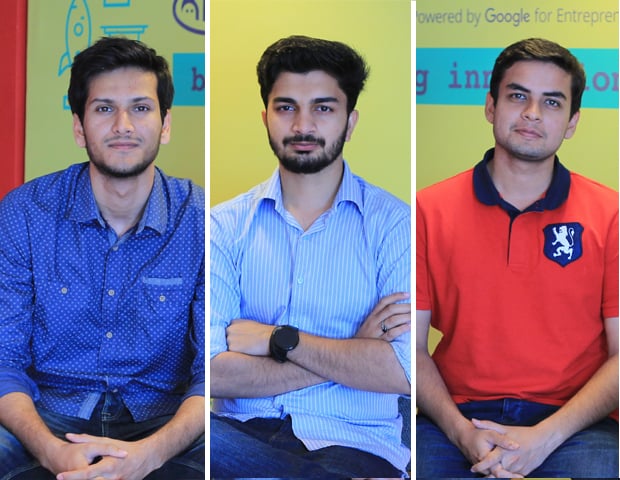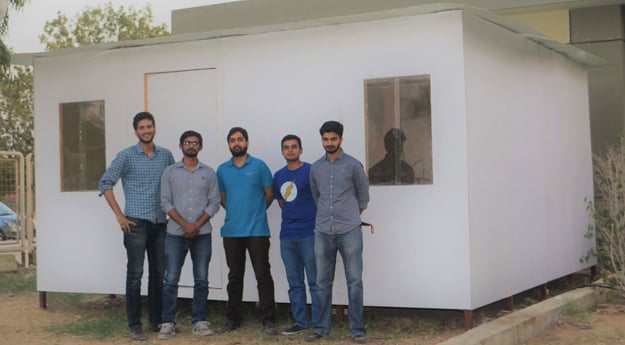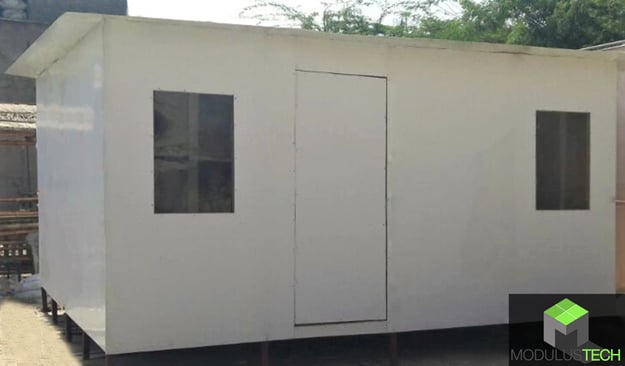
When three NED University’s civil engineering students Yaseen Khalid, Mohammed Saquib and Nabeel Siddiqui saw the devastation in Syria and the alarming situation of internally displaced persons at home, they decided to build exactly that kind of a housing solution for their final year project.

“We wanted to build something tangible that could be used in the real world to solve problems,” says Siddiqui.
But not everyone was convinced that they could make their vision a reality.
“When we presented our housing design to our university professors, everyone thought we were crazy and we couldn’t pull off the research, material sourcing and construction design by the time we graduated,” says Khalid.
Crazy or not, they found a mentor and supporter in one of their teachers who pushed them to explore the idea more.
“If the Chinese could build a 57-storey skyscraper in 19 days, we were convinced we could build houses in three hours,” adds Siddiqui.
But before they could implement the design they had created, the students needed some money to source the materials and test out the concept.
“We thought we’d get sponsorships from steel and cement companies very easily to build our first house. We went excitedly with our packages and offers to company CEOs and returned with nothing but goody bags and good wishes. No one wanted to give money to students,” says Saquib.
But the boys were still not discouraged and decided to put it all on the line.
“We bootstrapped, we begged our parents, we saved our pocket money, and we sold some stuff and finally got all the materials needed,” reminisces Khalid.
But just because they had the money to buy their materials and a friend’s backyard to put it together, it wasn’t all smooth sailing.
“We ended up buying the wrong material for a large portion of the money and when we started building our house the walls started falling apart,” laughs Siddiqui.
“It’s a good thing the retailer took back the materials, otherwise we would have lost over Rs50,000 on the wrong material and we didn’t have any more money for repurchase,” says Saquib.

The boys learnt from their errors and changed and customised the design as they went along.
“The labourers we hired would be flabbergasted at what we were doing. They just didn’t know what exactly we were trying to do?” says Siddiqui.
The boys not only managed to perfect their design that can be put together in three hours, is flat-packed, sustainable and cost-effective, they also ended up getting selected at tech incubator The Nest i/o in Karachi.
“When we pitched to the president Jehan Ara and her panel of esteemed judges, we thought we didn’t have a chance because we didn’t have an app or website or anything,” says Khalid about their company Modulus Tech.
But The Nest i/o saw their potential and selected them in their fifth incubation cycle. Currently, the boys have pivoted their idea and are catering to multiple industries with Modulus Tech.
“The mentoring and advice at the Nest made us realise that our housing solution could be great for labour colonies, tourist lodges, domestic quarters or military camps. They could even be used as health clinics and schools in slums and rural communities.”
Their time at the incubator has been like a mini-MBA program and they’ve understood how to build a business plan, pitch to investors, and how to monetise the business.
While their direction, passion and idea are brilliant, there are still many flaws in the design that have to be addressed in order to reach a larger audience and a different market. Take, for instance, the overall design that may be basic enough for refugees and IDP usage but is not aesthetically pleasing enough for a tourist lodge.
They also struggle with convincing their audience that this is a ‘house’ and not a shelter.
“Most people in Pakistan have this perception that a brick-and-mortar house must take time to build and it has to be expensive to put together otherwise it will not be long-lasting,” says Saquib. “Convincing them that it is just as sustainable and tough as any house is still a struggle.”
Currently, the boys are busy expanding their team, talking to investors and learning about scaling their business.
Saba Khalid is a freelance writer living between Karachi and Berlin.
The video and photos were provided by Modulus Tech.



1732256278-0/ellen-(1)1732256278-0-165x106.webp)
1725877703-0/Tribune-Pic-(5)1725877703-0-165x106.webp)
1732257537-0/Copy-of-Untitled-(64)1732257537-0-270x192.webp)
1726722687-0/Express-Tribune-Web-(9)1726722687-0-270x192.webp)










COMMENTS (24)
Comments are moderated and generally will be posted if they are on-topic and not abusive.
For more information, please see our Comments FAQ